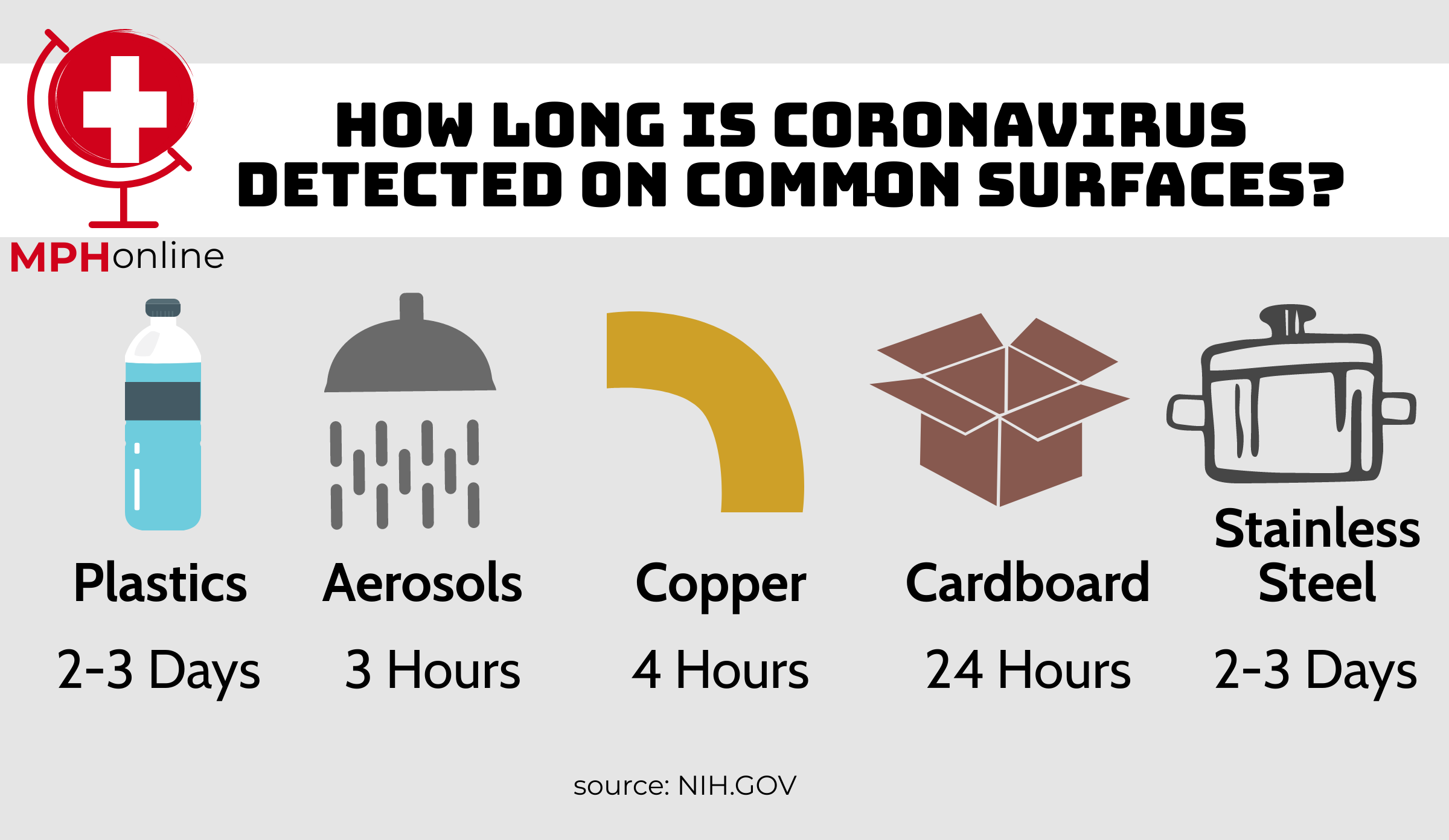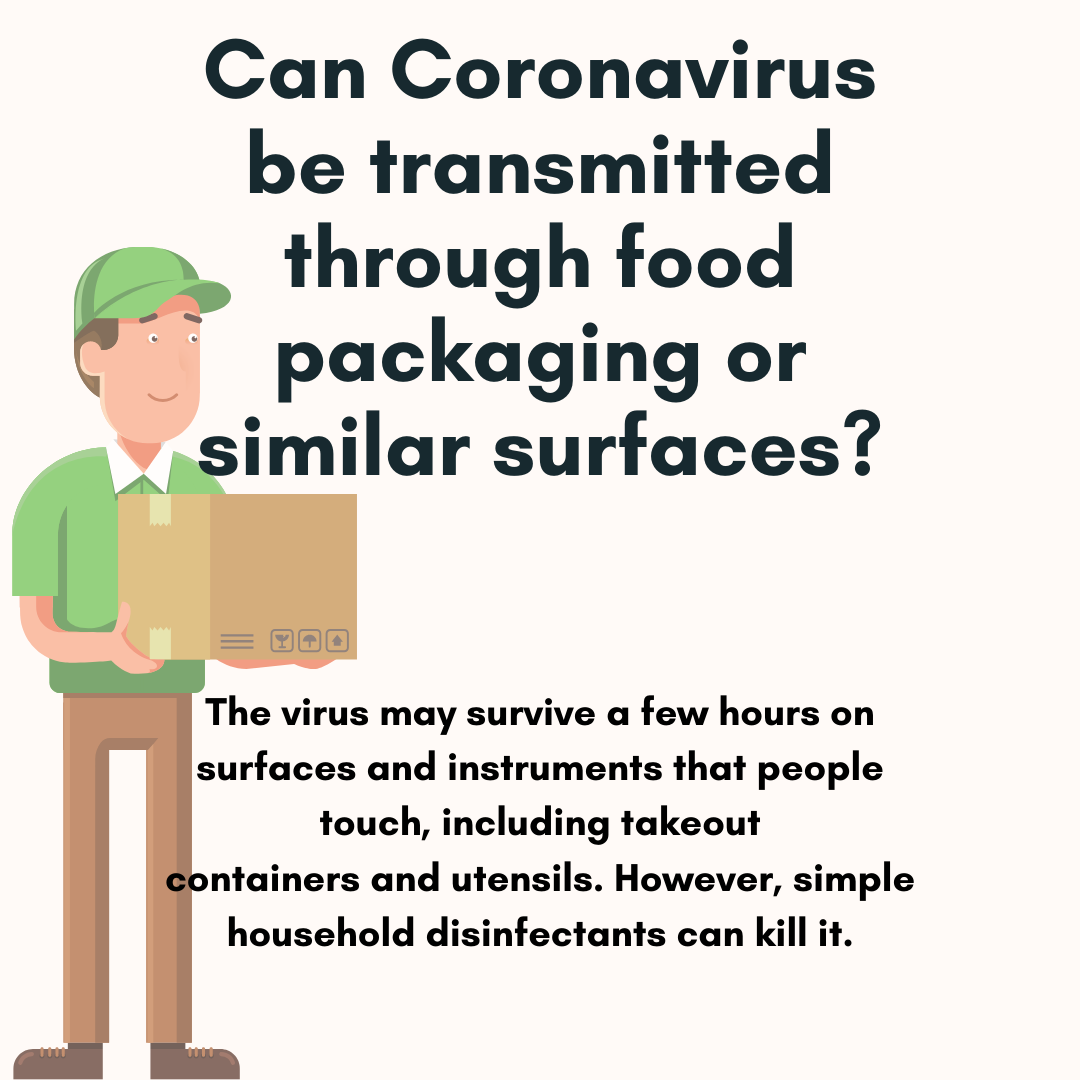With the worldwide Coronavirus pandemic currently affecting more than 3 million people around the world, one focus is on the disease and transmission possibilities. The questions often arise regarding how it can be spread. Can Coronavirus live on clothes? How long can it live on clothes, shoes, or other fabrics? Also, how long can it live on surfaces? For example, how long can COVID 19 on cardboard really survive? The idea that Coronavirus might be able to live on surfaces and clothing adds to the uncertainty of the COVID-19 situation.
It is natural to be nervous about the likelihood of catching the Coronavirus (COVID-19) infection, but an understanding of the facts can help to alleviate fears and confusion. Understanding can lead to more careful adherence to the recommended best practices for cleanliness, disinfecting, and other social practices. It starts to make sense why the CDC is making the medically valid recommendations that they are, based on research and the very latest findings by doctors and facilities both in the US and around the world. It becomes clear that the CDC guidelines should help to turn the tide and flatten the curve, leading to lower incidents of Coronavirus spread and contamination.

The most common way to transmit the Coronavirus is via close person-to-person interaction or contact, according to the Center for Disease Control (CDC). That is why social distancing, keeping at a distance of at least 6 feet in all directions, is recommended and encouraged at this time. While social distancing is the most common safety direction, there are still so many questions around the viability and possible concern around Coronavirus on clothes and surfaces. For all those questions around Coronavirus and how it survives on surfaces, here is a quick primer or overview with all the facts about COVID-19. It’s still important to contact a doctor or medical professional if there are questions about personal health, surface contamination, or other matters of wellness.
How long can Coronavirus live on clothes?
The primary focus of discussion around the Coronavirus (COVID-19) virus is on transmission by close contact, but clothes and other materials can hold and retain respiratory drops as well. Simply put, a person could get COVID-19 by touching a piece of fabric or other material. While it is possible for the virus to spread via touching clothes or fabric, the answer to the question of “how long can Coronavirus live on clothes” is more ambiguous. Some doctors and researchers claim that Coronavirus can live on fabric, but the consensus is that clothing and other fabric is a porous material, with a less hospitable environment for long-term viability. Even with the low probability of the spread of Coronavirus related to clothing or other fabrics, it never hurts to take extra precautions to clean, disinfect, and keep all clothing or other materials as clean as possible.
It is possible to compare cloth to cardboard and say that research has indicated 24-hour viability. Even those estimates are predicated by what virologists like Rachel Graham say about the testing conditions of the samples. The viability of COVID 19 on shoes or other fabric could be 24 hours in a perfect testing situation, but it is likely that Coronavirus would not last that long as a viable sample. It is still important to take Coronavirus exposure seriously, particularly when visiting a store, when hundreds of people may have been over the last 24 hours. Beyond the recommendations for maintaining the social distancing guidelines of 6 feet, refraining from touching one’s face, covering coughs and sneezes, frequently washing hands, some doctors and experts recommend changing clothes upon returning home after exposure to a significant number of individuals in a store or other potentially well-visited space. By taking special precautions, even in what has been called a low-risk situation, it may be possible to further protect and prevent the spread and contamination of Coronavirus.
What About Coronavirus on Shoes?
As an extension of clothes, some individuals are concerned about COVID 19 on shoes. In addition to clothes, the questions are about whether shoes or boots can track Coronavirus into a home or other dwelling. While the CDC offers guidelines and even an FAQ, there are currently no known cases of an individual contracting Coronavirus via their shoes, or via another person tracking or bringing the virus into the home. This is particularly important to note since healthcare individuals and other high-risk employees are frequently exposed to all manner of contamination in their day-to-day work. Other individuals regularly frequent areas where it is likely persons with Coronavirus might frequent, which could lead to contracting or carrying contamination on one’s clothing or shoes.

If there is ever any concern or worry about the possibility of contamination and exposing a family or other individual to Coronavirus, it is best to take additional precautions above and beyond the medical research and findings. For example, some experts have recommended removing shoes at the door or entryway and putting clothing in the wash. Even though clothing, shoes, and other items are considered low risk, there could be a reason to be particularly careful, based on personal health or familial wellness considerations. For some high-risk jobs, individuals may self-quarantine in a different location or housing situation between shifts and for prolonged periods of time to provide the best possible protection to family and other potentially at-risk individuals.
Even with a low-risk situation, take precautions. If a person who appears to be sick has coughed or sneezed directly on one’s clothes or shoes, it is important to wash the clothing or leave them in an isolated area to ensure that no further contamination occurs. The biggest and most common reason for taking extra-special care is when there is an immunocompromised, young, or elderly person in the home. Every possible precaution must be observed to protect and keep those potentially high-risk individuals safe. No precaution is too much when spread could mean severe consequences and health-related hazards.
Why is it important to understand how long the Coronavirus lives on surfaces?
It is not just that COVI-19 or that a lot of people have gotten sick. There have been many unknowns about the spread of the disease and how it is possible to contract it. Scientists, researchers, and doctors have been working to answer the most pressing questions regarding Coronavirus. So, part of the scare is misinformation, and part of the concern is that it is a dangerous pandemic virus that has taken the world by storm. So, it is important to understand why and how Coronavirus works, how long it lives on surfaces, and then what can be done to keep everyone safe and healthy. While doctors and researchers explore treatment options, it is essential to understand that everyday activities and actions can either help to prevent the spread, or they can help to exacerbate the spread.

While there is no one treatment that has been proven to be effective for Coronavirus, doctors continue to treat the symptoms and caution those who have not contracted the virus to practice all the recommended social distancing practices and safety protocols to effectively avoid getting sick. There has been some discussion about the possibility that the warmer months may slow the spread of the disease, which could alleviate fears more than anything. A recent report from National Academies of Science, Engineering, and Medicine (NAS) appears to suggest that those early hopes are unfounded. Or, at least, there is no evidence thus far to suggest that the seasonal change has not made a substantial impact on the viral spread thus far. It is still early, though. So far, it is difficult to determine what the progression or scope of research and study findings will entail.
How long can Coronavirus live on surfaces?
The Center for Disease Control (CDC) has released a range of research findings related to the viability of COVID 19 on surfaces. The CDC evidence shows that Coronavirus can live on surfaces for hours-to-days. In perfect, hermetically sealed scenarios, the testing has indicated that COVID 19 on cardboard could last for up to 24 hours. COVID 19 on paper could last for up to 24 hours as well. On these surfaces, it is difficult to clean and disinfect without damaging the item. It is still possible to spray the item with disinfectant. In many cases, recommendations for handling possibly contaminated boxes (for example, packages or other shipment materials) that may have Coronavirus on the surface, the recommendations include leaving it outside or in a separate area to wait out the 24-hour period of possible infectious viability.

To further protect against all possibilities of infection from surfaces, the CDC highlights their best recommendations for cleaning and disinfecting, via disinfectants approved by the Environmental Protection Agency (EPA). The EPA cautions to use the products as directed, with the appropriate contact time. They note that the substances are indicated for use on surfaces and should not be used on humans. The CDC offers a range of resources and further details about surface contamination, including precautions for cleaning and disinfecting surfaces, with special consideration for the special instructions required for electronics or other delicate surfaces. Just because it may be a delicate or not-easily-cleaned surface does not mean that some (more gentle) form of cleaning or disinfecting cannot take place. It may take more forethought and planning. It may be prudent and advisable to avoid using those surfaces, objects, or products that are the most difficult to clean and disinfect, if possible. Sometimes it’s just easier to avoid using those items that are most difficult to clean and disinfect instead of worrying about damaging them.
How long can Coronavirus last on surfaces?
The question of “How long can Coronavirus last on surfaces?” is a matter of understanding what the surface consists of, but following best practices for cleaning and disinfecting surfaces in a way that would help mitigate the danger of spread and contamination. The viability of COVID 19 on surfaces can vary depending on the substance. COVID 19 on cardboard can be viable for up to 24 hours and COVID 19 on paper could have a similar survival rate. These levels of contamination can be particularly concerning for workers and students since those are the materials that are most frequently used in an office or educational environment.
When you consider “how long can COVID-19 live on surfaces,” though, it is important to note that the Coronavirus virus may be viable on glass surfaces for up to 5 days. Coronavirus may last on a wood surface for up to 4 days, while it may be found on a plastic or stainless-steel surface for 3 days. Of all the materials currently tested for viability with the COVID-19 virus, copper surfaces appear to offer the least hospitable conditions for Coronavirus. The virus only lasts ~4 hours on a copper surface. While COVID 19 on cardboard could have a lifespan of up to 24 hours, the amount of live virus will decrease the longer it is on a surface. It still may be advisable to avoid touching surfaces. Or if touch is unavoidable, avoid touching the face or mouth. Wash hands as soon and as often as possible.
What does COVID 19 surface contamination mean?
COVID-19 surface contamination refers to the fact that the counters, objects, or items may represent a tactile danger. At any time, surfaces are associated with microbial contaminants, which consist of unwanted and potentially dangerous organisms (bacteria, spores, or cultures). It is not something that much of a worry on a day-to-day basis. The most aware individuals of this kind of surface contamination are those who are immunocompromised or in otherwise particularly susceptible to contaminants or unwanted material.
The other group of concerned individuals is likely those persons who are germophobic. In other words, they are already super-concerned and aware that germs are present on all surfaces, and they are hypervigilant. With the clear and present danger, everyone should try to be a little more germophobic right now. Situational awareness and a keen willingness to follow all the CDC guidelines and best practices should make a difference.
The testing and continued research into the Coronavirus pandemic both in the US and around the world have inspired a greater vigilance in health and wellness, as well as disinfectant measures. Given the fact that the COVID-19 virus has been found to be stable for days on surfaces, there is a reason for concern and special care. Everyone must take care to follow the recommended medical, health, and social guidelines developed by the CDC and other agencies. While the recommendations can add layers of complexity to social interactions, the focus is to make sure that friends, loved ones, and even acquaintances are safe, happy, and healthy.
How to avoid Coronavirus on surfaces or clothing
The best way to avoid COVID 19 on surfaces is to clean and disinfect, based on all the CDC guidelines. Those recommendations include wearing protective/disposable gloves, cleaning with soap and water, and being sure to vigorously clean all surfaces that are frequently used. Those surfaces include everything from countertops, tables, desks, light switches, sinks, faucets, keyboards, phones, etc. While there are many options for the products recommended or allowable as options for disinfectants, the solution for cleaning can be a form of diluted bleach solution, provided that special care and precautions are taken in keeping with handling considerations. Depending on what is most appropriate for the surface compatibility, it is possible to use a solution made up of at least 70% alcohol to clean and disinfect surfaces, particularly in situations where bleach-or-other disinfectant solutions are counter indicative.

For other, more porous of delicate surfaces, it might be better to use a soap-and-water solution for cleaning. For other contamination concerns on clothing, other fabrics, or materials, it is typically easiest to use a washer with appropriately warm water to disinfect materials. The CDC recommends taking special precautions when washing the clothes of a person who is sick or could be sick. Those safety considerations include waring gloves, refraining from shaking the clothes, and disinfecting the laundry basket. Then, even as all other precautions are followed with delicate surfaces and clothes, it is still important to wash hands, avoid touching one’s face, and use hand sanitizer as needed. While not all situations will be the same, and special considerations should be followed in case of need, the same basic tenets of cleaning and disinfecting remains consistent.
Other surfaces can be wiped down, or sprayed down, as appropriate. As much as possible, if a person shows signs of Coronavirus illness, that person should clean up after himself/herself including wiping down personal space, the bathroom after use, etc. To avoid surface contamination, the CDC recommends that sick individuals keep to their room if possible. In some ways, this separation is an extension of social distancing, although it tends to be a bit more complicated to keep a distance within the confines of a home. Pursuing the best, recommended practices for Coronavirus prevention is not always easy. With care and consideration, do whatever is possible to prevent and mitigate surface contamination and COVID-19 spread. While Coronavirus does not (and will not) affect everyone, it may just make a difference in ways that are never fully known.
Related:
Top 25 Free Online Public Health Courses to Take During a Pandemic
Best Practices During a Pandemic
A Comprehensive Pandemic Survival Kit List